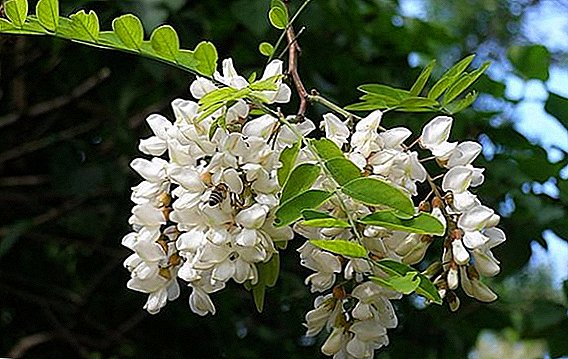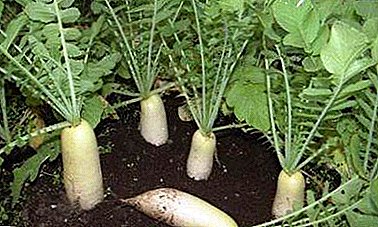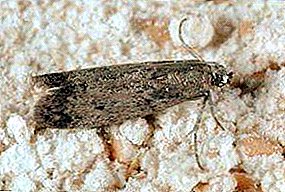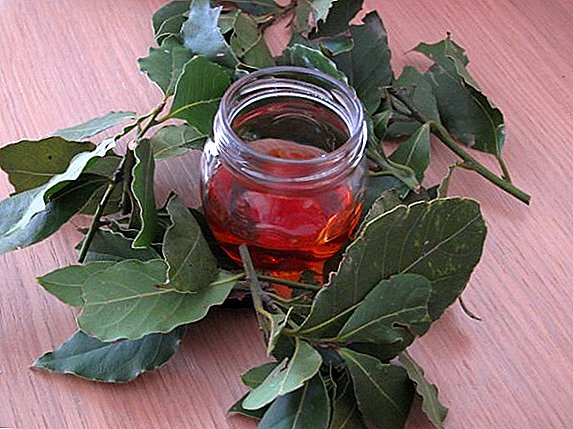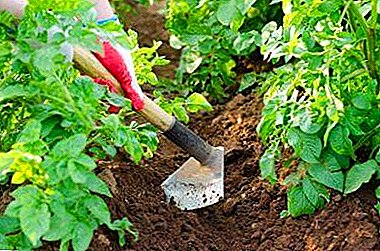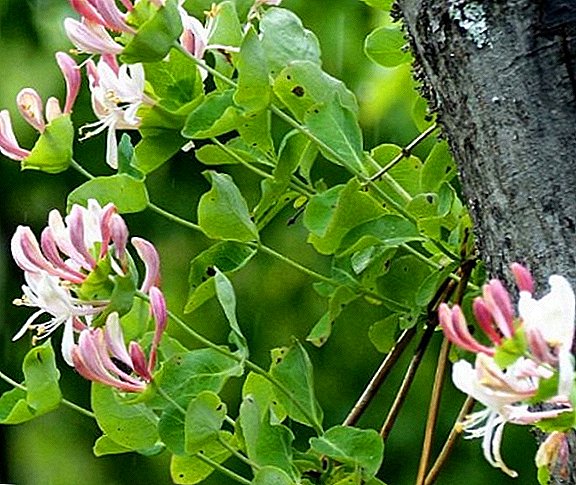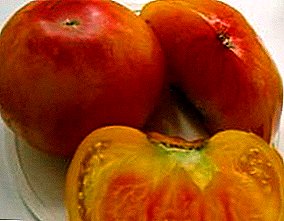
For even greater yield, experts advise planting several varieties or tomatoes in the greenhouse at the same time.
If you already have your favorite varieties, try growing a tomato with the interesting name Grapefruit and maybe it will also become your favorite.
And in our article you will find a complete description of this variety, its characteristics and characteristics of cultivation. This information will help you make a choice in favor of Grapefruit tomatoes for growing on your summer cottage.
Grapefruit Tomato: variety description
 The variety “Grapefruit” is “Tomato No. 1” according to many criteria - the size and color of the fruit, as well as its amazing taste. Variety derived as a result of breeding several countries recently. In the state register of the Russian Federation has not yet been included. Indeterminate plants, not standard, can reach up to 2 m in height, a sheet of potato type. Read about determinant varieties of tomatoes here.
The variety “Grapefruit” is “Tomato No. 1” according to many criteria - the size and color of the fruit, as well as its amazing taste. Variety derived as a result of breeding several countries recently. In the state register of the Russian Federation has not yet been included. Indeterminate plants, not standard, can reach up to 2 m in height, a sheet of potato type. Read about determinant varieties of tomatoes here.
By the time of ripening fruits - late, up to 180 days. The variety is well resistant to many diseases subject to additional prophylaxis and proper care. Be sure to think about the treatment of late blight, one of the most common methods - spraying of copper sulphate. Read our articles on the most common diseases of tomatoes in greenhouses and measures to combat them.
In greenhouse conditions, "Grapefruit" can be grown throughout the year, in the open ground - in the warm regions of the country in the summer. Usually, up to 15 fruits are gathered from the bush per season. Grapefruit is a medium-yielding variety.
| Grade name | Grapefruit |
| general description | Late, indeterminate variety of tomatoes for growing in greenhouses and greenhouses. |
| Ripening | up to 180 days |
| The form | Rounded, slightly flattened. |
| Colour | Red with yellow. |
| Average tomato mass | 600 grams |
| Application | It is consumed fresh. |
| Yield varieties | up to 9 kg from 1 plant |
| Features of growing | Bush requires a pinching. The best results are obtained when forming a plant in 1 and 2 stalks. |
| Disease resistance | Requires prevention of late blight. |
Of the merits noted:
- large fetal size;
- interesting color;
- high disease resistance.
Negative feedback on the variety was not found, a disadvantage can be called late ripening. A feature is the color of fruits of medium ripeness, like a grapefruit.
Characteristics of the fetus:
- Unripe fruits are green, they are no different from the others, but they are interesting in their maturity - the skin is yellow-red, the flesh is also full of the same colors, although ideally there should be a yellowish skin and red flesh.
- Also, the fruit is impressive in size - rounded, slightly flattened on top can reach up to 1 kg, an average of about 600g.
- The plant has an average yield (up to 9 kg per plant), with its size it easily exceeds the plan of high-yielding varieties.
- The solids content is high, there are no chambers, the minimum number of seeds.
- Stored on average not bad.
Yield varieties can be compared with others:
| Grade name | Yield |
| Grapefruit | 9 kg from a plant |
| American ribbed | 5.5 kg per plant |
| Sweet bunch | 2.5-3.5 kg from a bush |
| Buyan | 9 kg from a bush |
| Doll | 8-9 kg per square meter |
| Andromeda | 12-55 kg per square meter |
| Lady shedi | 7.5 kg per square meter |
| Banana red | 3 kg from a bush |
| Golden anniversary | 15-20 kg per square meter |
| Rose of Wind | 7 kg per square meter |
Table grade, not suitable for juice production due to its density. For whole-fruit preservation, the fruits are too large; you can only roll them into cans by cutting them into several pieces, processing them into a sauce or a salad. For use in raw fits perfectly, the taste is really "tomato". And also rather big - up to 600 and even 1000 grams of fruit weight.
Compare this figure with other varieties can be in the table:
| Grade name | Fruit weight |
| Grapefruit | 600 grams |
| Verlioka | 80-100 grams |
| Fatima | 300-400 grams |
| Yamal | 110-115 grams |
| Red Arrow | 70-130 grams |
| Crystal | 30-140 grams |
| Raspberry jingle | 150 grams |
| Cranberries in sugar | 15 grams |
| Valentine | 80-90 grams |
| Samara | 85-100 grams |
A photo
View some photos of grapefruit tomato:


Care instructions
The region for growing in greenhouses can be selected any, in warm regions it is better to plant in open ground. Landing on seedlings in early March. Seeds should be soaked in a growth stimulator solution for a day, landed in pots or mini-greenhouses, dive when a third leaf is formed.
It is necessary to harden the seedlings for more successful grafting in the greenhouse. Landing for permanent residence is not difficult. Planted in a greenhouse of glass or polycarbonate in mid-May, in open ground at the end of June. During the flowering period should be abundantly watered plants. Fertilizers with mullein and mineral fertilizers are carried out 3 times per season. Several times spend loosening the soil.
Tomato feeding can be done with a variety of drugs.:
- Organic fertilizers.
- Yeast
- Iodine
- Hydrogen peroxide.
- Ammonia.
 We offer you some more useful materials about growing tomatoes:
We offer you some more useful materials about growing tomatoes:How to do mulching and what is it for. As well as options for the use of boric acid in the cultivation of tomatoes.
“Grapefruit” requires pasynkovany for the formation of one stem every 10 days until the beginning of August. Pysynki size of more than 4 cm can not be removed, it will damage the plant. Because of the high growth of plants and large fruits need a garter. The methods are different for everyone - the stakes next to each plant, the use of a trellis or individual wire structures.
Diseases and pests

Phytophthalosis of tomatoes
It is necessary to regularly spray tomatoes with special solutions against pests. The main harm is caused by: the Colorado potato beetle, aphids, spider mites, slugs and medvedki. You do not need to stock up on pests and diseases for the future, use different means to avoid pests getting used to them. If preventive measures do not help, you can apply insecticides.
Tomatoes "Grapefruit" begin to ripen in cold weather - in early September, therefore, spraying against late blight is obligatory. To do this, use the following recipe: 1 liter of milk and a few drops of iodine dissolved in a bucket of water. In the case of the appearance of the disease, special microbiological agents should be used. Read about late blight resistant varieties here.
We also bring to your attention information about such diseases of tomatoes as Fusarium and Verticillus.
Conclusion
Tomatoes "Grapefruit" will not be superfluous in the greenhouse, will delight you with tasty fruits in September. Read also about how to get a magnificent harvest of tomatoes in the open field and winter greenhouse, how to grow early varieties and what high-yielding and disease-resistant varieties should be paid attention to.
In the table below you will find useful links about tomato varieties with different ripening periods:
| Middle late | Medium early | Superearly |
| Volgogradsky 5 95 | Pink Bush F1 | Labrador |
| Krasnobay F1 | Flamingo | Leopold |
| Honey salute | Mystery of nature | Schelkovsky early |
| De Barao Red | New königsberg | President 2 |
| De Barao Orange | King of Giants | Liana pink |
| De barao black | Openwork | Locomotive |
| Miracle of the market | Chio Chio San | Sanka |


